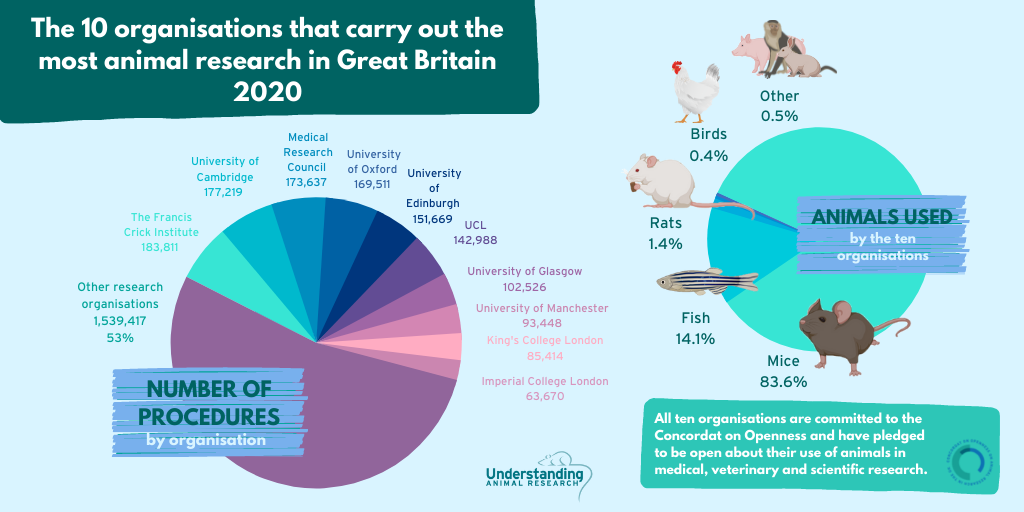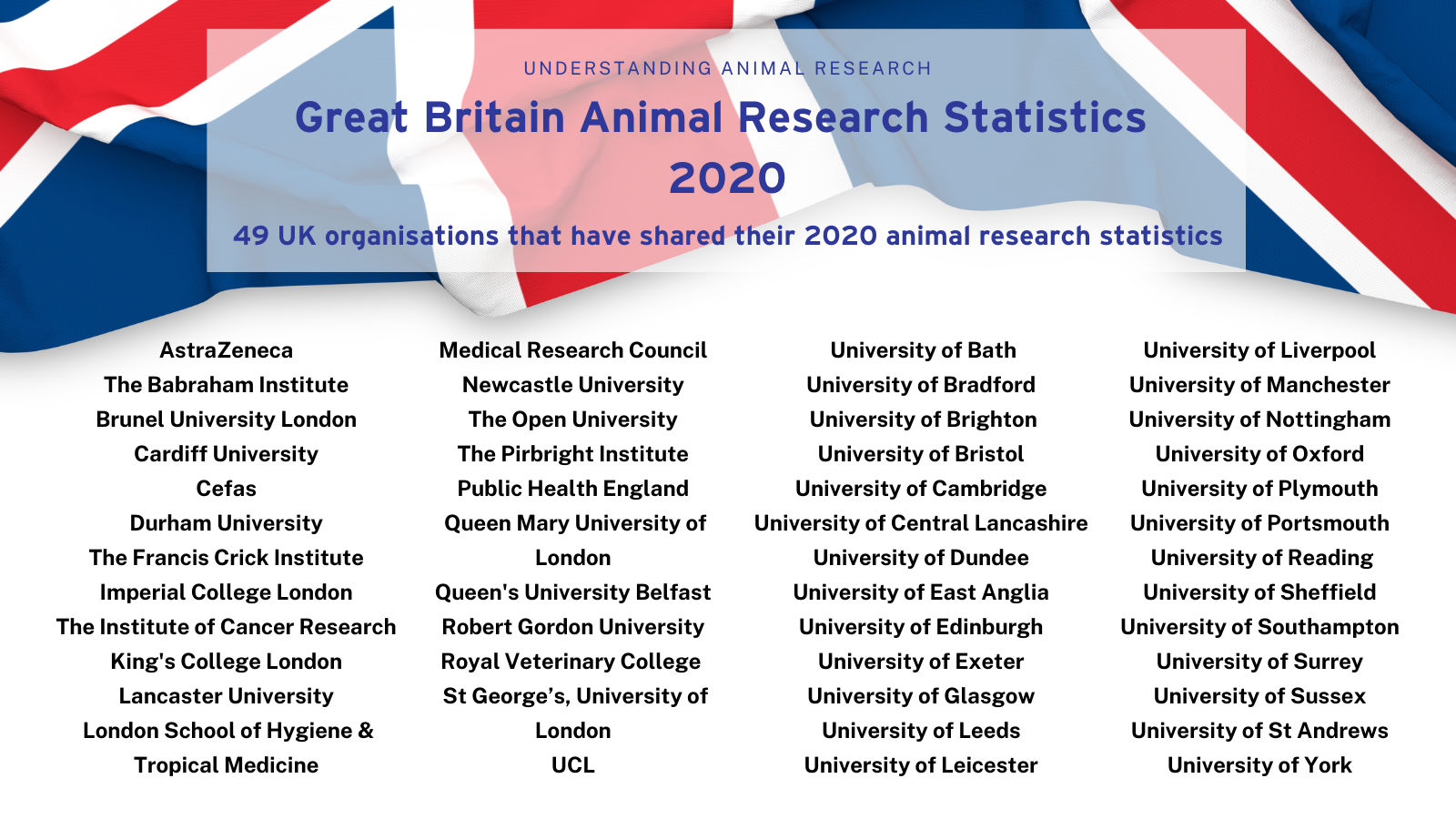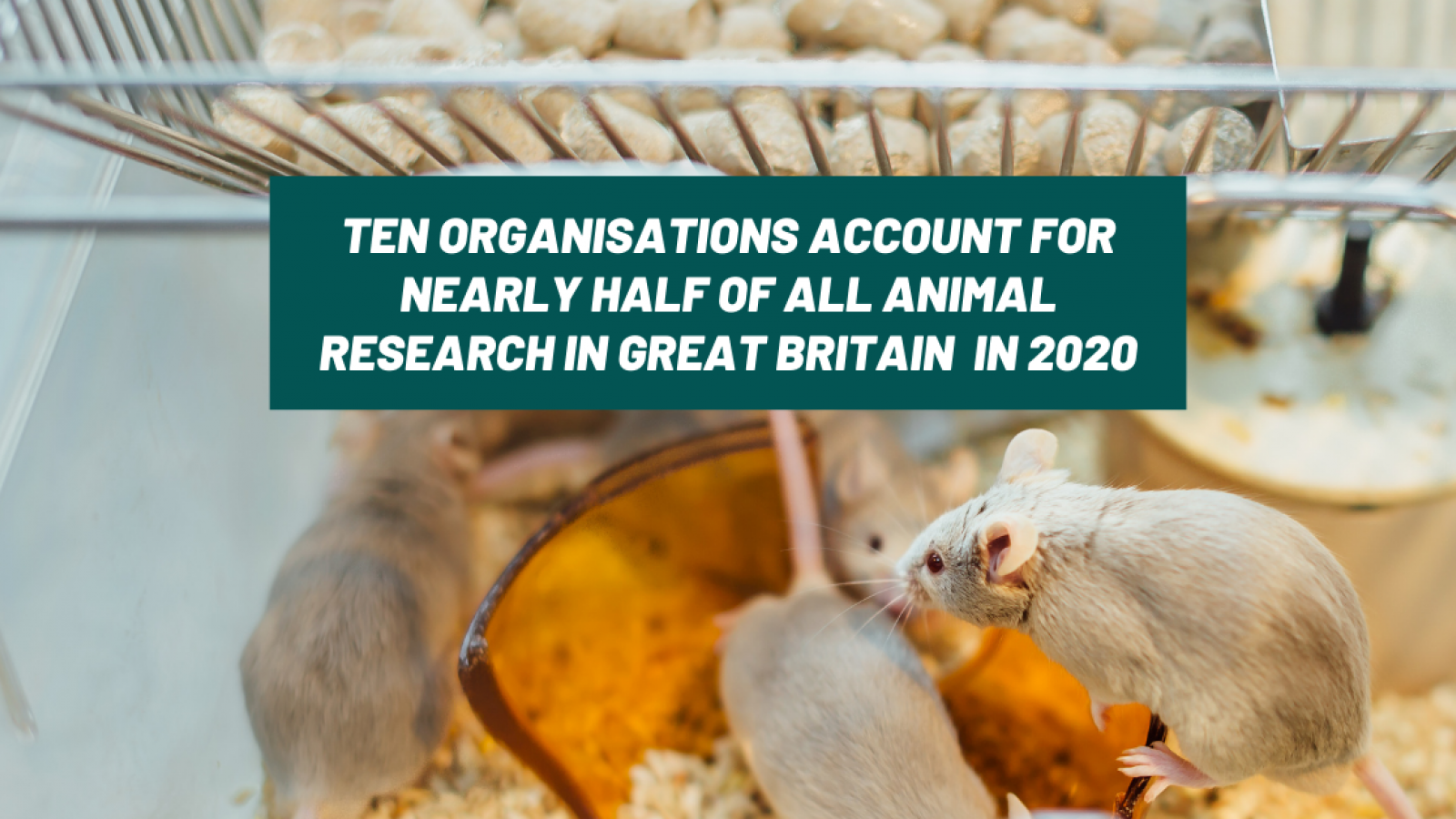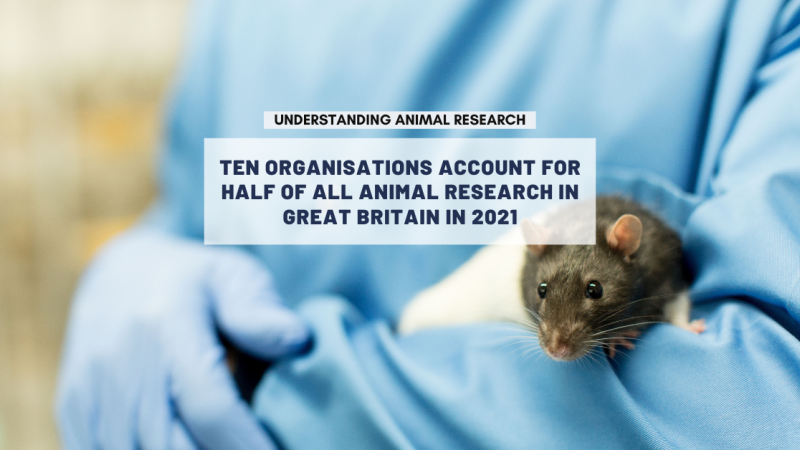Ten organisations account for nearly half of all animal research in Great Britain in 2020
-
All ten organisations have committed to open communications around animal research
-
49 UK organisations share their own 2020 animal research statistics
-
Animal research case studies highlighted
Understanding Animal Research (UAR), an organisation that promotes open communications about animal research, has today (15 July 2021) published a list of the ten organisations in Great Britain that carry out the highest number of animal procedures – those used in medical, veterinary, and scientific research. These statistics are freely available on the organisations’ websites as part of their ongoing commitment to transparency and openness around the use of animals in research.

This list coincides with the Home Office’s publication of Great Britain’s statistics for animals used in research in 2020. More information on the UAR website.
These ten organisations carried out 1,343,893 procedures, 47% or nearly half of the 2,883,310 procedures carried out in Great Britain in 2020*. More than 99% of these 1,343,893 procedures were carried out in rodents or fish.
The ten organisations are listed below alongside the total number of procedures that they carried out in 2020. Each organisation’s name links to its animal research webpage, which includes more detailed statistics. This is the sixth consecutive year organisations have come together to publicise their collective statistics and examples of their research.
|
Organisation |
Number of Procedures |
|
183,811 |
|
|
177,291 |
|
|
173,637 |
|
|
169,511 |
|
|
151,669 |
|
|
142,988 |
|
|
102,526 |
|
|
93,448 |
|
|
85,414 |
|
|
63,670 |
|
|
TOTAL |
1,343,893 |
Animal research and Covid-19
Animal research has been essential for developing lifesaving vaccines and treatments for Covid-19. Ferrets and macaque monkeys were used to test the safety and efficacy of Covid-19 vaccines, including the successful Oxford-AstraZeneca vaccine. Hamsters are being used to develop Covid-19 treatment strategies as they display a more severe form of the disease than ferrets and monkeys. Guinea pigs have also been used in regulatory research to batch test vaccine potency.
Despite all this research to develop vaccines and treatments for Covid-19, the majority of UK research facilities carried out significantly less research than usual, due to the various national lockdowns. Therefore, the 2020 figures cannot be reasonably compared with previous statistics.
49 organisations have published their 2020 animal statistics
To accompany the Top Ten list, UAR has also produced a list (see appendix) of 49 organisations in the UK that have shared their own statistics on the animal research they carried out in 2020.

All organisations are committed to the ‘3Rs’ of replacement, reduction and refinement. This means avoiding or replacing the use of animals where possible; minimising the number of animals used per experiment and optimising the experience of the animals to improve animal welfare. However, as institutions expand and conduct more research, the total number of animals used can rise even if fewer animals are used per study.
All organisations listed are signatories to the Concordat on Openness on Animal Research in the UK, a commitment to be more open about the use of animals in scientific, medical and veterinary research in the UK. More than 120 organisations have signed the Concordat including UK universities, medical research charities, research funders, learned societies and commercial research organisations.
Wendy Jarrett, Chief Executive of Understanding Animal Research, which developed the Concordat on Openness, said:
"Animal research has been essential to the development and safety testing of lifesaving COVID-19 vaccines and treatments. Macaque monkeys and ferrets have been used to develop vaccines, including the Oxford-AstraZeneca vaccine, hamsters are being used to develop treatments, and guinea pigs are used to quality-check each batch of vaccines. Animal testing provided scientists with initial data that the vaccines were effective and safe enough to move into human clinical trials. During these trials, thousands more humans than animals were used to test how effective and safe the vaccines were in people. The pandemic has led to increased public interest in the way vaccines and medicines are developed and UAR has worked with research institutions and funding bodies throughout the UK to develop resources that explain to the public how animals have been used in this critical research."
Jan-Bas Prins, Director of the Crick’s Biological Research Facility, said:
“The pandemic has shone a light on the continuing value of animal research, including the role it has played in supporting the development of safe and effective vaccines. And it has also opened up new ways of working, including greater emphasis on bioinformatics and improved data sharing globally. Although advances in alternative methods have reduced the need to use animals for some experiments, our bodies are complex and many systems have yet to be recreated artificially. This means scientists still need to use animals to study a wide range of conditions including infectious diseases, cancer and developmental problems, while putting great efforts into developing and implementing non-animal methods at the same time.”
MRC Executive Chair Professor Fiona Watt, said:
“The MRC has been working to support the rapid development of treatments and vaccines for COVID-19 and, in doing so, is committed to ensuring the highest possible levels of animal welfare and to replacing, refining and reducing the use of animals where possible. Early animal studies were key to establishing the safety and efficacy of the different COVID-19 vaccines that are now being rolled out to millions of people every day across the world.”
The Covid-19 vaccine team from the University of Oxford, said:
"Animals still play an important part in the development of vaccines for both humans and animals, with both safety and efficacy needing to be demonstrated before a vaccine can move on to human trials. In the case of the Oxford-AstraZeneca Covid-19 vaccine, rhesus macaques were used as one animal model because as primates they are close relatives to humans and have been widely used in medical research in the past, which gives us a good understanding of how closely their immune systems resemble ours.Rhesus macaques are currently the recommended animal species for testing coronavirus vaccines, and because we do not have the facilities to conduct these experiments in Oxford these two studies were conducted in partnership with Public Health England and the National Institutes of Health in the US."
Dr Martin Vinnell, Establishment Licence Holder, University of Cambridge, said:
“Animal research currently plays an essential role in our understanding of health and disease and in the development of modern medicines and surgical techniques. Without the use of animals, we would not have many of the modern medicines, antibiotics, vaccines and surgical techniques we take for granted in both human and veterinary medicine. We always aim to use as few animals as possible, refining our research and actively looking for ways of replacing their use, for example in the development of ‘mini-organs’ grown from human cells, which can be used to model disease.”
-Ends-
Notes to Editors
The hashtag for social media is #AnimalStats.
A list of recent animal research case studies from contributing organisations can be found below.
Further information on the Concordat on Openness on Animal Research in the UK can be found here: http://concordatopenness.org.uk
These figures refer to procedures using animals for medical, veterinary, or scientific research, as licensed by the UK’s Home Office. The use of animals to test tobacco products was banned in the UK in 1997 and it has been illegal to use animals to test cosmetic products in this country since 1998. A policy ban on household product testing using animals was introduced in 2010. Since 2013, it has been illegal to sell or import cosmetics anywhere in the UK or the EU where the finished product or its ingredients have been tested on animals.
*The Home Office recorded 2,883,310 completed procedures in 2020, 1,343,893 (47%) of which were carried out at these ten organisations.
Full table of statistics from top ten organisations:
|
Organisation |
Total Procedures (2020) |
Mice |
Fish |
Rats |
Birds |
Non-Human Primates |
Other |
|
The Francis Crick Institute |
183,811 |
172,098 |
11,206 |
|
|
|
507 |
|
University of Cambridge |
177,219 |
102,050 |
72,009 |
2,511 |
|
43 |
608 |
|
Medical Research Council |
173,637 |
173,401 |
176 |
6 |
|
54 |
|
|
University of Oxford |
169,511 |
163,738 |
4,681 |
955 |
|
15 |
122 |
|
University of Edinburgh |
151,669 |
111,603 |
27,171 |
6,811 |
4,745 |
|
1,339 |
|
UCL |
142,988 |
100,041 |
39,684 |
2,863 |
|
|
400 |
|
University of Glasgow |
102,526 |
95,371 |
4,505 |
929 |
824 |
|
897 |
|
University of Manchester |
93,448 |
80,408 |
10,711 |
1,638 |
|
|
691 |
|
King's College London |
85,414 |
68,394 |
15,490 |
1,401 |
|
|
129 |
|
Imperial College London |
63,670 |
56,883 |
3,562 |
2,106 |
175 |
|
944 |
|
TOTAL |
1,343,893 |
1,123,987 |
189,195 |
116,398 |
5,744 |
110 |
5,637 |
All numbers represent completed procedures on animals in 2020. The number of procedures carried out using animals will be slightly higher than the number of animals used, as a small number of animals may be used in more than one procedure.
List of 49 UK organisations that have shared their 2020 animal research statistics:
AstraZeneca
The Babraham Institute
Brunel University London
Cardiff University
Cefas
Durham University
The Francis Crick Institute
Imperial College London
The Institute of Cancer Research
King's College London
Lancaster University
London School of Hygiene & Tropical Medicine
Medical Research Council
Newcastle University
The Open University
The Pirbright Institute
Public Health England
Queen Mary University of London
Queen's University Belfast
Robert Gordon University
Royal Veterinary College
St George’s, University of London
UCL
University of Bath
University of Bradford
University of Brighton
University of Bristol
University of Cambridge
University of Central Lancashire
University of Dundee
University of East Anglia
University of Edinburgh
University of Exeter
University of Glasgow
University of Leeds
University of Leicester
University of Liverpool
University of Manchester
University of Nottingham
University of Oxford
University of Plymouth
University of Portsmouth
University of Reading
University of Sheffield
University of Southampton
University of Surrey
University of Sussex
University of St Andrews
University of York
Case studies:
The Francis Crick Institute
Understanding the threat of coronavirus variants
In January, researchers at the Crick joined a new national research consortium to study the effects of emerging SARS-CoV-2 variants. The ‘G2P-UK’ National Virology Consortium, brings together leading virologists from 10 UK research institutions.
They are tasked with studying new mutations in the virus and flagging the riskiest variants as they arise, such as those associated with fast spreading virus clusters or the potential to escape vaccination efforts. At the Crick, we are creating a bespoke and biologically secure facility to study the latest variants of interest in animals, including mice and hamsters.
David LV Bauer, Group Leader of the RNA Virus Replication Laboratory says: “We’ve seen the harm that new virus variants can cause so it’s important to be able to respond quickly if they look concerning. Patterns of spread can take a long time to spot in the community but by using animal models, we can quickly understand whether a new variant poses significant threat.”
University of Cambridge
Restoring movement to paralysed limbs
A team in the University of Cambridge’s Department of Engineering is developing implantable devices to bypass nerve damage and restore movement to paralysed limbs.
“Our aim is to make muscles wireless by intercepting electrical signals from the brain before they enter the damaged nerve and sending them directly to the target muscles via radio waves,” says Sam Hilton, a Research Assistant in the team.
The procedure has been tested and refined in computer simulations, and on cells grown in the lab. But before it can be tested in humans there is another important step: testing its safety in living rats. To avoid testing in animals entirely would place untenable risk on the first human recipients of this new device. All the experiments are carefully designed to ensure that just enough animals are used to produce convincing data, without resulting in unnecessary excess.
By working out how complex microelectronics can interface with living tissue in a very precise and controlled way, this work has potential to improve or restore movement in patients suffering severe nerve damage - improving their quality of life and easing the burden on our healthcare services.
https://www.cam.ac.uk/stories/nervebypass
Medical Research Council
New insights into fibromyalgia
Fibromyalgia is a chronic, long-term condition that causes pain all over the body. The cause of fibromyalgia is unknown; however, it is believed to involve a combination of genetic and environmental factors. In a ground-breaking study that transforms our understanding of the disease, MRC-funded researchers at King’s College London used mice to show intriguing insights that will accelerate the development of novel therapies.
The team purified a type of antibody called immunoglobulin G (IgG) from fibromyalgia patients and transferred it to mice. The mice then went on to develop symptoms that were characteristic of fibromyalgia; hypersensitivity to pain, reduced grip strength, and reduced movement. This passive transfer of symptoms from injecting immunoglobulins purified from patients is the most direct and straightforward evidence that fibromyalgia is most likely an autoimmune disease. And excitingly, these results suggest that therapies which reduce the activity of IgG could be effective in treating fibromyalgia.
Recent guidelines for treating chronic primary pain, issued by the National Institute for Health and Care Excellence (NICE) discourage the use of all licensed pain relief medication. This is because there is little or no evidence that they make any difference to people’s quality of life, pain or psychological distress, but they can cause harm, including possible addiction. The possibility of new treatments that can address the root cause of fibromyalgia rather than just the symptoms, by reducing the activity of IgG, offers hope to the millions of fibromyalgia patients around the world. Basic research involving animals is therefore vital for gaining a deeper understanding into disease mechanisms that have remained largely unexplained until now and allow researchers to progress in finding new ways to improve human health.
University of Oxford
Developing Covid-19 vaccines
As with most human vaccines, there were several animal species used in testing before progressing to safety and efficacy trials of the Oxford-AstraZeneca Covid-19 vaccine, including mice, ferrets, pigs and Rhesus macaques. Several of these trials were carried out jointly with partner institutions including the Rocky Mountain Laboratories in the USA (NIH) and Porton Down in the UK (PHE).
Rhesus macaques were used in this study because as primates they are close relatives to humans. Rhesus macaques have been widely used in medical research in the past, which gives us a good understanding of how closely their immune systems resemble ours. These are currently the recommended animal species for testing coronavirus vaccines.
University of Edinburgh
Drug acts as Trojan horse to kill cancer cells
A light-activated drug that can enter and kill cancer and bacterial cells without harming nearby healthy cells has been tested successfully in zebrafish and in human cells.
Scientists found that combining the tiny cancer-killing molecule with a chemical food compound can trick cancer cells into ingesting the drug.
The molecule – called SeNBD – is smaller than existing light-sensitive treatments, which means it can pass through the cell’s defences much more easily.
As well as being small enough to enter cells, SeNBD is also a type of drug called a photosensitiser, which means that it kills cells only after it is activated by visible light.
Switching on the drug with light means a surgeon could decide exactly where they want the drug to be active, avoiding the chances of attacking healthy tissue and preventing the kind of side effects, such as hair loss, caused by other anticancer treatments.
Researchers say the new drug may offer a safe and quick method of treating early-stage cancers and drug-resistant bacteria. Further research is now needed to confirm and hone this exciting advance.
UCL
Spina bifida can be caused by uninherited genetic mutations
Genetic mutations which occur naturally during the earliest stages of an embryo’s development can cause the severe spinal malformation spina bifida, finds a new experimental study in mice led by UCL scientists. The study explains for the first time how a ‘mosaic mutation’ – a mutation which is not inherited from either parent (either via sperm or egg cell) but occurs randomly during cell divisions in the developing embryo – can cause spina bifida.
In this experimental study, researchers caused a specific mutation, which inactivates a single gene called Vangl2, in a small proportion of cells in mouse embryos which form their developing spinal cord. The researchers validated and used a refinement technique which avoids needing to inject research animals by feeding them necessary substances instead. Using another refinement and reduction technique, they also performed some experiments in embryo culture (grown outside the uterus), so they could avoid needing to treat as many pregnant mice.
The scientists, based at UCL Great Ormond Street Institute of Child Health, found that when a mutation in the gene was present in 16% of developing spinal cord cells of mouse embryos, this was sufficient to produce spina bifida.
Researchers say the findings add to scientists’ understanding of how and why mosaic mutations can affect and disrupt cell function, including those of neighbouring cells, stopping organs from forming normally. They say these results show that the cellular signalling process involving the Vangl2 gene is surprisingly vulnerable to the uninheritable mosaic mutations.
For parents, the findings may help reduce the burden felt by those who believe their child inherited spina bifida from them, and believe future children could also inherit the condition. https://www.ucl.ac.uk/news/2021/feb/spina-bifida-can-be-caused-uninherited-genetic-mutations
King's College London
Understanding platelet activation during lung infection
Researchers atKing’s College London have been busy developing mouse models of lung infection to better understand how platelet activation affects respiratory infections.Platelets are circulating cells in the blood, and are essential for clotting, but researchers now understand that platelet activation can also be controlled by inflammatory molecules, which leads to different functions compared to molecules that cause platelets to aggregate and the clotting of blood.
Understanding how this distinction occurs can have relevance to our understanding of Covid-19, where patients sometimes present with too much inflammation which damages the lungs (hyper-inflammation) and abnormalities to clotting (pulmonary emboli). Therefore, this team from KCL use various procedures in mice to detect platelet recruitment and activation to the lungs (for example techniques to count cells in tissue, and to track platelet movement in real-time), and changes to normal blood function (bleeding time, platelet aggregation).
These physiological processes are integrated through whole body responses and can therefore only be understood using mice models. The team use these mouse models to also characterise the importance of future drug targets that are key to platelet activation during infection and inflammation, through drug efficacy profiling, at the same time cross-checking whether alterationsin blood clotting occur.
University of Glasgow
New insight into early stages of bowel cancer could provide an effective treatment strategy
A recent study, led by researchers at the Cancer Research UK Beatson Institute at the University of Glasgow and the University of Helsinki, used mouse models to identify key factors underpinning the development of bowel or colorectal cancer in patients with a genetic predisposition to the disease.
The Nature study provided a crucial insight into the early stages of bowel cancer, and also identified a molecule that is a ‘key player’ in this process. The breakthrough information could lead to new ways to prevent tumour development in high-risk individuals.
The study’s mouse models looked at APC, one of the most commonly mutated genes in colorectal tumours, to identify how APC mutant cells compete with neighbouring normal cells. The researchers discovered the involvement of a molecule called NOTUM in the development of the disease. They hope that one day it will be possible to deploy NOTUM inhibitors, some of which are currently under development, as a possible early treatment. APC loss gives cells a competitive advantage over their non-mutant neighbours, making them very good at forming cancer in the gut. In this study, researchers used model systems to uncover what causes APC-mutant cells to become super-competitors and drive the very early stages of colorectal cancer. Pinpointing the involvement of the molecule NOTUM in these early stages of colorectal cancer could be the key to preventing the disease in high-risk individuals.
University of Manchester
Researchers discover a backup natural pacemaker in the heart
Researchers at The University of Manchester have discovered a backup natural pacemaker, which is able to generate a pulse and control the heart rate.
The study ‘completely changes our understanding’ of the heart’s anatomy and has important implications on the work of cardiologists and heart surgeons.
As part of the study, published in Frontiers in Physiology, University scientists carried out research involving 15 goats.
Subsequent data analysis found that a ‘subsidiary atrial pacemaker’ (SAP) takes over from the nearby sinoatrial, or SA Node, the primary way the heart generates electrical signals that make it beat, when it fails.
Lead author Dr Halina Dobrzynski, from The University of Manchester, said: “This study completely reshapes our understanding of the how the heart works and is tremendously exciting. It builds on our work on the human heart over many years and we hope will make an important contribution to future treatments.”
The SA node in human, goat and other mammalian species is a group of cells located in the wall of the right atrium of the heart which have the ability to spontaneously produce the electrical impulses to make our hearts beat.
The team is confident the discoveries are highly relevant to the human heart, as the organ in goats has similar anatomy and physiology, producing a similar heart rate.
Imperial College London
Gene therapy shows potential for treating childhood brain disorder
Researchers from Imperial College London used mouse models to create a gene therapy with potential for treating a debilitating childhood neurological condition called CDKL5 deficiency disorder. The condition affects the developing brain, and its symptoms can include severe epilepsy and autism.
The team developed a treatment that aims to introduce a functional version of the CDKL5 gene into brain cells. They used a modified virus that crosses the blood-brain barrier to deliver working copies of the gene to see if it could restore some of the function lost in the condition.
In a proof-of-concept study, juvenile mice that lacked functioning CDKL5, and displayed many of the characteristics found in people with CDKL5 deficiency disorder, had some of their impaired brain functions restored with a single treatment of the gene therapy. The research team is now keen to see if the therapy could be further developed and taken to clinical trials.
Last edited: 28 October 2022 15:00




